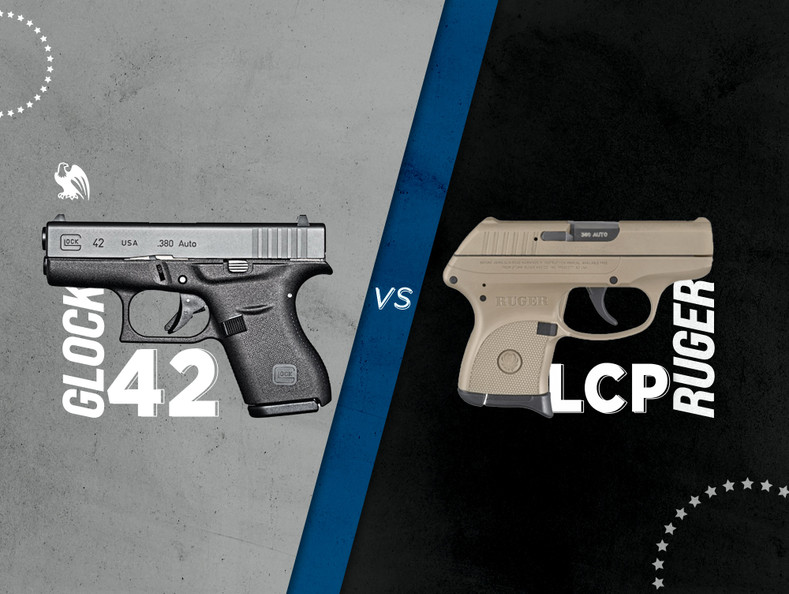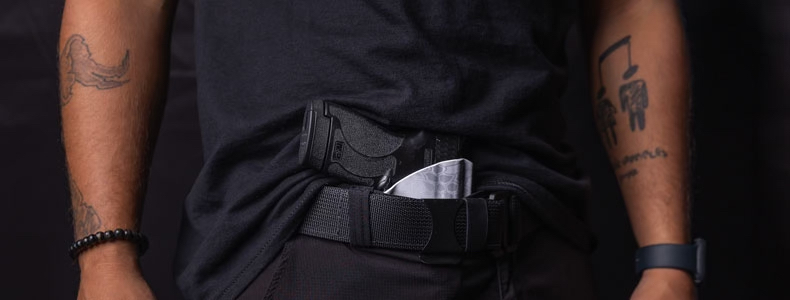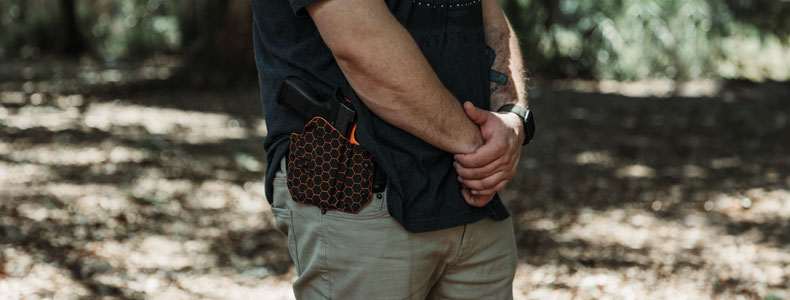Glock 42 vs Ruger LCP: Which Is the Better Pistol?

If you’re looking for a small pistol for concealed carry, it’s no surprise the Glock 42 and Ruger LCP made it onto your radar. Both are lightweight, reliable guns from well-known manufacturers.
But what are the features that make each of these models unique?
When comparing the Glock 42 vs LCP, it’s easy to see plenty of similarities between the two. Both have a 6-round capacity, are chambered in 380 Auto, and feature factory sights. The main differences are their trigger action and size, with the subcompact G42 being striker-fired and a bit larger than the hammer-fired micro-compact LCP.
In this article, we’ll break down the differences between these two firearms to help you narrow it down to the right one for you.
Products Mentioned In This Article
Glock 42

If you're a Glock fan and want the smallest option out there, the Glock 42 is hard to beat. Its ultra-compact size and smooth shooting experience have earned it a strong reputation in the concealed carry world.
Chambered in .380 Auto, this striker-fired pistol features a black polymer frame and a Tenifer-coated ordinance-grade steel slide. Like most Glocks, it’s equipped with the Safe-Action trigger system, which consists of three independent mechanical safeties. The standard magazine holds 6 rounds, but if you’re after a bit more capacity, extended mags are available.
Measuring under an inch wide, the Glock 42 is one of the slimmest models Glock makes. It's a great option for deep concealment in any carry position. You can browse these pistols here, or check out our selection of Glock 42 holsters.
Ruger LCP

When the Ruger LCP 380 Auto was first introduced to the concealed carry market in 2008, it quickly gained popularity due to its lightweight and compact design.
This centerfire pistol is built with a through-hardened alloy steel slide and glass-filled nylon grip frame. It is chambered in 380 Auto and comes standard with a 6-round magazine, though you can find extended magazines that increase its capacity.
The LCP features a comfortable textured grip, fixed front and rear sights, a recessed hammer, and a finger grip extension floorplate that can be added to fit more hand sizes.
Overall, the LCP is a popular choice for concealed carry due to its lightweight design and affordability. You can browse these pistols here, or check out our selection of Ruger LCP holsters.
Glock 42 vs LCP: Specs
LCP vs Glock 42: Size & Capacity

The Glock 42 vs Ruger LCP size comparison is fairly straightforward. Both are 380 Auto pistols with a 6-round magazine capacity and extended mag options. But that’s where the similarity ends.
The subcompact Glock 42 is larger and heavier than the micro-compact Ruger LCP. The G42 is 4.13 inches tall, 5.94 inches long, and 0.98 inches wide, with a barrel length of 3.24 inches and a weight of 13.76 ounces. The LCP, on the other hand, is only 3.6 inches tall, 5.16 inches long, and 0.82 inches wide, and it weighs 9.6 ounces.
Ruger LCP vs Glock 42: Frame, Slide & Barrel
The G42 is designed with a subcompact black polymer frame and built-in beaver tail for a high and tight grip. It also has a Tenifer-coated ordinance-grade steel slide with rear serrations.
The Ruger LCP is built with a high-performance glass-filled nylon textured grip micro-compact frame and includes a finger grip extension plate that can be added to the magazine for improved comfort and grip. It has a black oxide alloy steel barrel and a through-hardened steel slide with rear slide serrations.
Glock 42 vs Ruger LCP: Sights & Optics
Both the Ruger LCP and the Glock 42 come standard with factory sights. The LCP has low-profile fixed front and rear sights that are integral to the slide, while the 42 has Glock’s standard plastic sights. Neither pistol comes optics-ready.
Glock 42 vs LCP: Controls

Trigger
The trigger is another area in which the Glock 42 and Ruger LCP vary drastically. While the LCP has a single-action trigger that feels somewhat like a DAO, the G42 is striker-fired and has a light take-up with more of a rolling break.
Safety
Neither gun model has a manual thumb safety. The Glock 42, however, is equipped with Glock’s Safe Action System. This system consists of three independent mechanical safeties that disengage as the trigger is pulled and re-engage as it is released.
FAQ: Ruger LCP vs Glock 42
Is Ruger as Reliable as Glock?
Some people are under the impression that because Ruger is a budget-friendly manufacturer, its weapons must be of lower quality than brands like Glock, which has a strong reputation.
However, this is not necessarily the case. Glock and Ruger are both trusted, reputable companies that craft functional and reliable firearms. If you are choosing between the two, it all comes down to your personal preferences and budget. Either way, as long as you take care of it, you’ll have a dependable firearm that you can rely on for personal defense.
Is a 380 Good for Self-Defense?
The .380 ACP is one of the most popular calibers in smaller handguns. And while some would argue that this caliber is too small for a defensive scenario, this is not true. The .380 ACP round is considered the minimum caliber for concealed carry and has been an effective choice for self-defense for over a century.

Although it’s true the .380 ACP does not have the same energy or long-distance accuracy as larger calibers like 9mm or .45, it does have more than enough stopping power to be lethal. This, combined with the small size of most .380 pistols, makes them a popular and sufficient choice among concealed carriers and law enforcement alike for everyday carry or as a backup weapon.
To take a deep dive into this topic, check out our article breaking down the best calibers for self-defense.
What Does LCP Stand For?
The Ruger LCP family has evolved beyond the original LCP model, and now includes the Ruger LCP, the LCP II, and the LCP MAX. But what does LCP even mean?
According to Ruger, LCP stands for “Ligh
tweight Compact Pistol” and was originally designed to be used as a backup weapon for law enforcement and concealed carriers.
Which is Right For Me?

If you’re trying to choose between the Glock 42 vs LCP, there are a few main differences to consider. The first is size. While the G42 is a subcompact pistol that weighs 13.76 ounces, the LCP is a micro-compact that weighs only 9.6 ounces.
These guns also have different trigger systems. While the Glock 42 is striker-fired, the Ruger LCP has a single-action design. The Ruger LCP’s MSRP is also almost half of the Glock 42’s, making it significantly more affordable, which is a major factor for many people.
At the end of the day, the best pistol for you comes down to your personal needs and preferences. Whichever you choose, you can rest easy knowing you’re carrying a reliable, easy-to-conceal weapon that works great for EDC.
Looking for a reliable, custom-fit holster? Visit our Holsters by Gun Model page to find Kydex holsters tailored to your firearm. Plus, explore our Resources Page for gear recommendations, concealed carry guides, and exclusive content to elevate your carry system.



